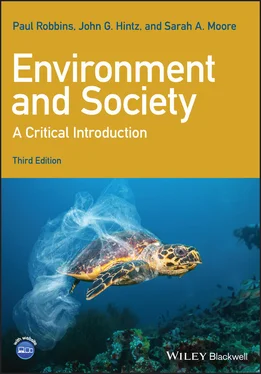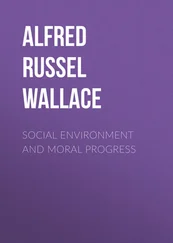It has been estimated, for example, that if we calculate carrying capacity based on an assumption that all people lived like people do in the United States , the Earth could sustain only two billion people, or less than one-third of the world’s current population (Chambers et al. 2002). If this is taken seriously, we might have to ask how we can possibly decide who should be allowed to live at what standard of living. In other words, is it reasonable to insist that China not develop any further, so that levels of consumption in the United States and Europe can remain the same? Should people in North America demand that India limit its growth so that North Americans (in the United States and Canada) can maintain their own standard of living? For many people, these extremely problematic ethical questions have led to a desire to decrease their own impact on the environment – their ecological footprint.
The idea of an ecological footprint analysis is not so much to define the potential of an area to support a particular number of people at a particular standard (although it can do that), but rather to estimate the total area of productive land and water required to produce the resources for and assimilate the waste from a given population. While this can be done at multiple scales – some people use it to analyze the environmental impacts of entire urban areas, or even countries – many people find it useful to estimate how their own daily practices of eating, showering, driving, using the bathroom, washing their clothes, etc. affect the environment. There are many websites available that allow users to enter their own data and receive a number representing their impact on the environment. Of course, you can always view this data with a degree of skepticism, but for many people it is a real eye-opener (“my restaurant dinners add 20 square kilometers to my footprint!”). So even if human population will never truly “exhaust” the Earth, it is reasonable to ask what quality of life might be expected in specific places with large populations (e.g. Phoenix, Arizona) to ask what obligations the wealthy have to the Earth upon which they tread so heavily, and to consider policies that might bend the demographic curve (see Box 2.1 ).
The Other Side of the Coin: Population and Innovation
Given the many scenarios of famine, scarcity, and ecological disaster typically laid at the feet of population growth, it might be hard to imagine that there are many thinkers, researchers, and historical observers who actually make the reverse argument: population growth is the root of innovation and civilization. Yet there is a great deal of evidence to support this claim.
In this way of thinking, a growth in human numbers, given a relative scarcity of available resources, induces the search for alternatives and new ways of making more from less. Looking back at agricultural development over thousands of years, there is evidence to suggest that this happens all the time in the provision of food. This is because historically food was produced using extensive production techniques – meaning large areas of land were used for the production of limited amounts of food. Environmental systems (especially soil fertility) impose such limits on production because it is typically the case that the amount of food that can be grown on the same land after a season or two of cropping tends to decrease. The simplest remedy for such soil exhaustion is fallowing of land, meaning that the field is left to rest for a season or more. During the time that the field is at rest, land is cultivated elsewhere.
Such a system is perfectly straightforward and feasible for a limited population. But as human numbers grow and demand for food increases, either the number of fields must be increased (making the production system more extensive – that is, using more land) or the population will have to rotate through their fallow land more quickly, resting the land less often, if at all. If the latter decision is made, then some way of maintaining the fertility of the soil and therefore growing more food on the same amount of land must be devised. The history of agriculture is replete with such innovations, from soil fertilization using manure and more modern inputs to complex systems of intercropping where different crops are used together or in rotation to maintain soil fertility, rather than continuously cropping the same food plant. As explained in Ester Boserup’s (1965) now-classic analysis, Conditions of Agricultural Growth , over long periods of history the amount of food produced on the same amount of land has increased exponentially, because demands for food rise with increases in population. More people means more food. This thesis is referred to as induced intensificationand can be extended to all kinds of other problems and natural resources (see Chapter 3).
Owing to new cultivation techniques and input-heavy systems of agricultural production, the so-called Green Revolution, food production has boomed worldwide. Wheat production in India tripled between 1965 and 1980, for example, far outpacing the rate of population growth. In Indonesia during the 1970s, rice production increased by 37%. In the Philippines it increased by more than 40%. The period from the middle 1960s to the present in fact has been a period in which more food has been produced than consumed, and in which more people have been moved above the level of starvation than in the century prior.
Green RevolutionA suite of technological innovations, developed in universities and international research centers, which were applied to agriculture between the 1950s and 1980s and increased agricultural yields dramatically, but with a concomitant rise in chemical inputs (fertilizers and pesticides) as well as increased demands for water and machinery
Induced IntensificationA thesis predicting that where agricultural populations grow, demands for food lead to technological innovations resulting in increased food production on the same amount of available land
Nevertheless, a number of other environmental problems came with the Green Revolution and the expansion of food production, including the loss of unbroken soils across the prairies and rainforests of the Earth, and a concomitant loss in biodiversity. Where new land is not used to increase food supplies, increased intensity of production has also meant a massive input of fertilizers and pesticides. These chemicals take a toll on the land and are themselves made from petrochemicals, meaning that they depend upon petroleum extraction and manufacturing, with all of the environmental implications of that system. Energy is necessary, moreover, to produce farm equipment (like tractors, and harvesters), and to power that equipment. All of this energy comes from the ongoing exploitation of increasingly scarce petroleum resources, the production of which is costly and environmentally devastating. Each calorie of food in the years following the Green Revolution has become far more ecologically expensive. There appears to be no such thing as a free lunch.
These outcomes also raise questions about the problem of scale in assessing the impact of population. Agriculture might expand dramatically in a densely populated part of Brazil, for example, to produce soybeans for both consumption and industrial applications, with serious implications for the forest these crops replace. The “population” that drives this demand, however, lives thousands of miles away in Europe and the United States, and thrives in a high-impact lifestyle under conditions of low population density and growth. The circulation of agricultural products makes assessing the impact of local, regional, and global populations extremely difficult.
Читать дальше











